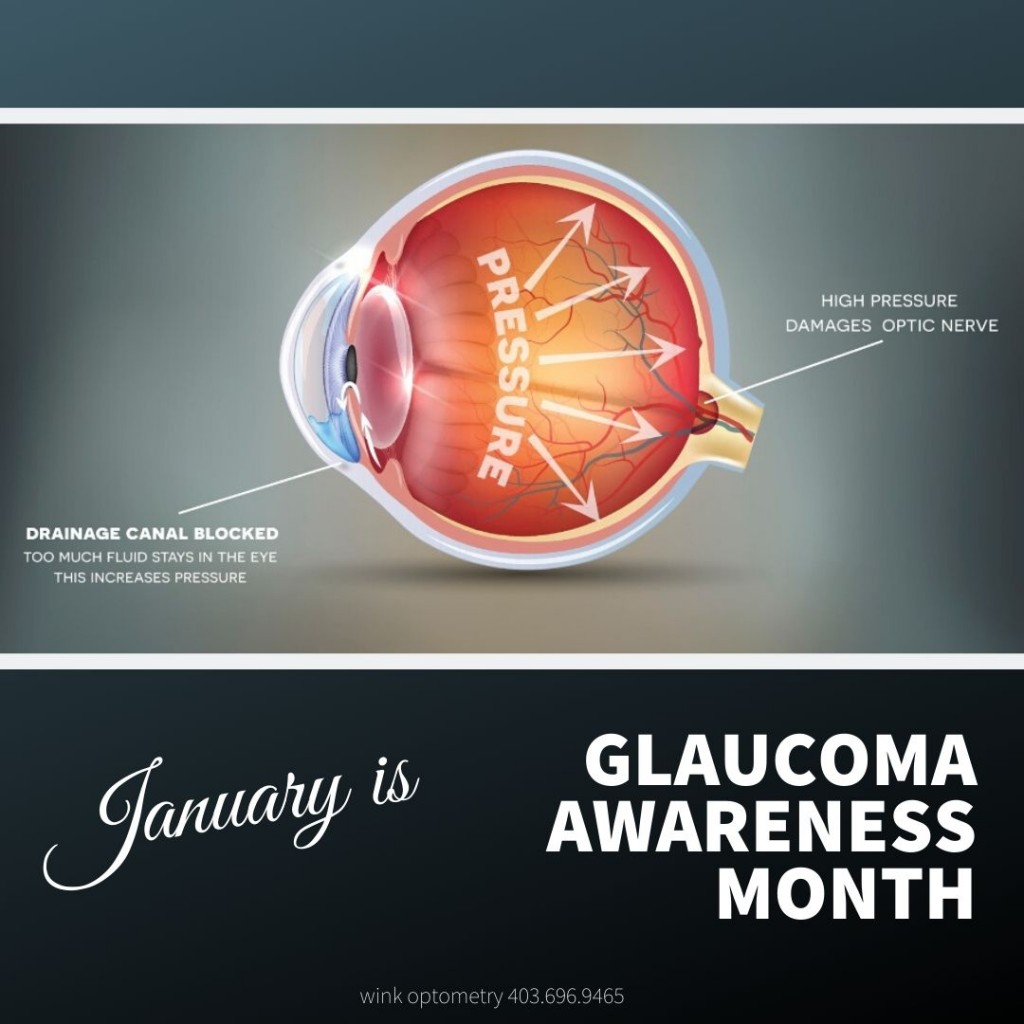January is Glaucoma Awareness Month
January 16th 2020
Glaucoma is one of the leading causes of blindness amongst Canadians. It is often referred to as the “silent thief of sight” as it often presents itself without any symptoms or warning signs. The effect is so gradual that most do not notice a change in vision until the condition is at an advanced stage.
Glaucoma is a group of eye diseases which leads to the degeneration of the eyes optic nerve. This in turn can lead to nerve tissue loss, which results in irreversible permanent vision loss and potential blindness if not detected and treated early enough. Your best defense against glaucoma is fairly simple – ensure you visit your optometrist regularly for a comprehensive eye examination.
What Causes Glaucoma?
The exact cause of glaucoma is unknown. Glaucoma is typically associated with increased intraocular pressure (IOP) within the eye; however, nerve damage can also occur when the eyes pressure is completely normal.
Risk Factors
- Age – people over the age of 60 are at an increased risk for the disease. The risk of developing glaucoma increases slightly with each year.
- Family History – If someone in your family has glaucoma, your risk of developing the disease increases.
- Medical conditions such as hypertension, heart disease, and diabetes – if you suffer from any of these medical conditions, you are at an increased risk of developing glaucoma according to most studies
- Physical injuries/traumas to the eyes – severe trauma, such as being hit in the eye, can result in an immediate increase in the eye's pressure, and can cause future increases due to internal damage. An injury can also dislocate the eyes crystalline lens, closing the drainage angle, which in turn causes an increase in pressure as well.
- Other eye-related risk factors – things like eye anatomy, such as corneal thickness and optic nerve appearance, indicate risk for developing glaucoma. Other conditions such as retinal detachments, eye tumours and eye inflammations may also induce glaucoma
- Extended use of corticosteroids – using corticosteroids for a prolonged period of time appears to put some people at risk of developing secondary glaucoma.
Forms of Glaucoma:
Primary Open-Angle Glaucoma – This is the most common form of glaucoma. This form is caused by the slow clogging of the eyes drainage canals, resulting in increased intraocular pressure. The human eye is continuously producing fluid, called aqueous fluid. If too much aqueous fluid is produced, or the fluid is not draining properly, it can cause pressure on the optic nerve, thus increasing intraocular pressure.
The increased pressure damages the eyes optic nerve by reducing the amount of blood that can get through the tiny blood vessels that supply the nerve, and also by squashing the nerve itself. The eyes optic nerve transmits all the information the eye sees and relays that information to the brain to be processed. When the eyes optic nerve is damaged, the amount and quality of information that the brain receives decreases, and vision loss occurs. Most times, a person’s peripheral vision is affected first, then followed by central vision in the diseases most progressed advanced stages.
This type of glaucoma develops slowly and is a lifelong condition. It often gives no warning symptoms in the early stages. There is no pain and, in many cases, a person with this condition is completely unaware of the damage that has been done to their field of vision. This is because the characteristic damage occurs in the off-center parts of the field of vision. Both eyes work together as a team, and when one eye is not working at 100%, the other eye “fills in” for the other eye, so the blank patches are not noticed.
“Open-angle” means that the angle where the iris meets the cornea is as wide and open as it should be.
Angle-Closure Glaucoma - this type of glaucoma is known as closed-angle glaucoma or narrow angle glaucoma and is not as common as primary open angle glaucoma. Angle-closure glaucoma is considered a medical emergency and demands immediate medical attention as it develops quickly and can cause vision loss in as little as a day.
This type of glaucoma occurs when the drainage angle in the eye closes or becomes blocked, resulting in a sudden rise in intraocular pressure.
Unlike open-angle glaucoma, angle-closure glaucoma is the result of the angle where the iris meets the cornea is closed or very narrow
Normal-Tension Glaucoma – This type of glaucoma is also called low-tension or normal-pressure glaucoma. In normal-tension glaucoma, the optic nerve is damaged even though the eye pressure is not high and stays within “normal range”. Why this type of glaucoma occurs is still unknown.
Secondary Glaucoma – This type of glaucoma is typically as a result of an injury, infection, or tumor in or around the eye, that causes the intraocular pressure to rise. It may also be the result of certain medical conditions, medications, and eye abnormalities. Infrequently, eye surgery can also be associated with secondary glaucoma
Congenital Glaucoma – this type of glaucoma occurs in babies where there is incorrect or incomplete development of the eye’s drainage canals during the prenatal period. This is considered a rare condition that may be inherited. When uncomplicated, microsurgery can often correct the structural defects, other cases are treated with medication and surgery.
Treatment:
Depending on the type of glaucoma you may have, treatment options with certain medications or surgery may vary. Typically, treatment with daily eye drops and/or laser surgery is usually effective at maintaining your vision, but once vision is lost due to glaucoma, it cannot be restored. Patients with glaucoma must continue treatment for the rest of their lives. Since the disease can progress or change silently, compliance with treatment and eye examinations is essential.
As previously stated, regular eye examinations with your optometrist are the only way to screen and prevent glaucoma. Give us a call today to schedule your appointment!

Click to close

